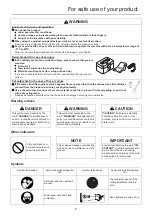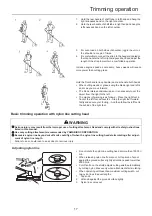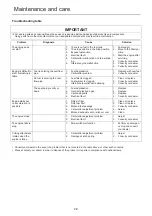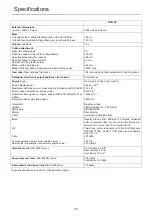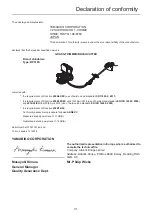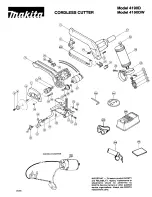
18
Trimming operation
Trimming
This is feeding the trimmer carefully into the material you wish
to cut. Tilt the head slightly to direct the debris away from you.
If cutting up to a barrier such as a fence, wall or tree, approach
from an angle where any debris ricocheting off the barrier will
fly away from you.
Move the nylon line cutting head slowly until the grass is cut
right up to the barrier, but do not jam (overfeed) the line into
the barrier. If trimming up wire mesh or chain link fencing, be
careful to feed only up to the wire. If you go too far, the line will
snap off around the wire.
Trimming can be done to cut through weed stems one at a
time. Place the nylon line cutting head near the bottom of the
weed never high up, which could cause the weed to chatter
and catch the line. Rather than cut the weed right through, just
use the very end of the line to wear through the stem slowly.
1. Angle
to
wall
2. Debris
3.
Knife side raised
4. Angle
to
ground
Scything
This is the cutting or mowing of large grassy areas by sweep-
ing or swinging the trimmer in a level arc. Use a smooth, easy
motion. Do not try to hack or chop down the grass. Tilt the ny-
lon line cutting head to direct the debris away from you on the
scything stroke. Then return without cutting grass for another
stroke. If you are well protected and do not care whether some
debris is thrown in your direction, you may scythe in both di-
rections.
Scalping and edging
Both of these are done with the nylon line cutting head tilted at
a steep angle. Scalping (A) is removing top growth, leaving the
earth bare. Edging (B) is trimming the grass back where it has
spread over a pavement or driveway. During both edging and
scalping, hold the unit at a steep angle in a position where the
debris, and any dislodged dirt and stone, will not come back
towards you even if it ricochets off the hard surface.
Although the pictures show how to edge and scalp, every op-
erator must find for himself the angles which suit his body size
and cutting situation.
For nearly all cutting, it is good to tilt the nylon line cutting head
so that contact is made on the part of line circle where the line
is moving away from you and the shield (See appropriate pic-
ture). This results in the debris being thrown away from you.
Tilting the head to the wrong side will shoot the debris toward
you. If the nylon line cutting head is held flat to the ground so
that cutting occurs on the whole line circle, debris will be
thrown at you, drag will slow the engine, and you will use up a
lot of line.
Nylon line cutting head rotates anticlockwise. The knife will be
on the left side of the shield.
1. Debris
2. Cut on this side
Summary of Contents for BP510S
Page 2: ...2 ...
Page 67: ...33 X750 026920 X750222 7601 2015 1Remarques et dos de couverture NOTES ...
Page 68: ...34 X750 026920 X750222 7601 2015 NOTES ...
Page 69: ...35 X750 026920 X750222 7601 2015 NOTES ...
Page 135: ...3 ...


